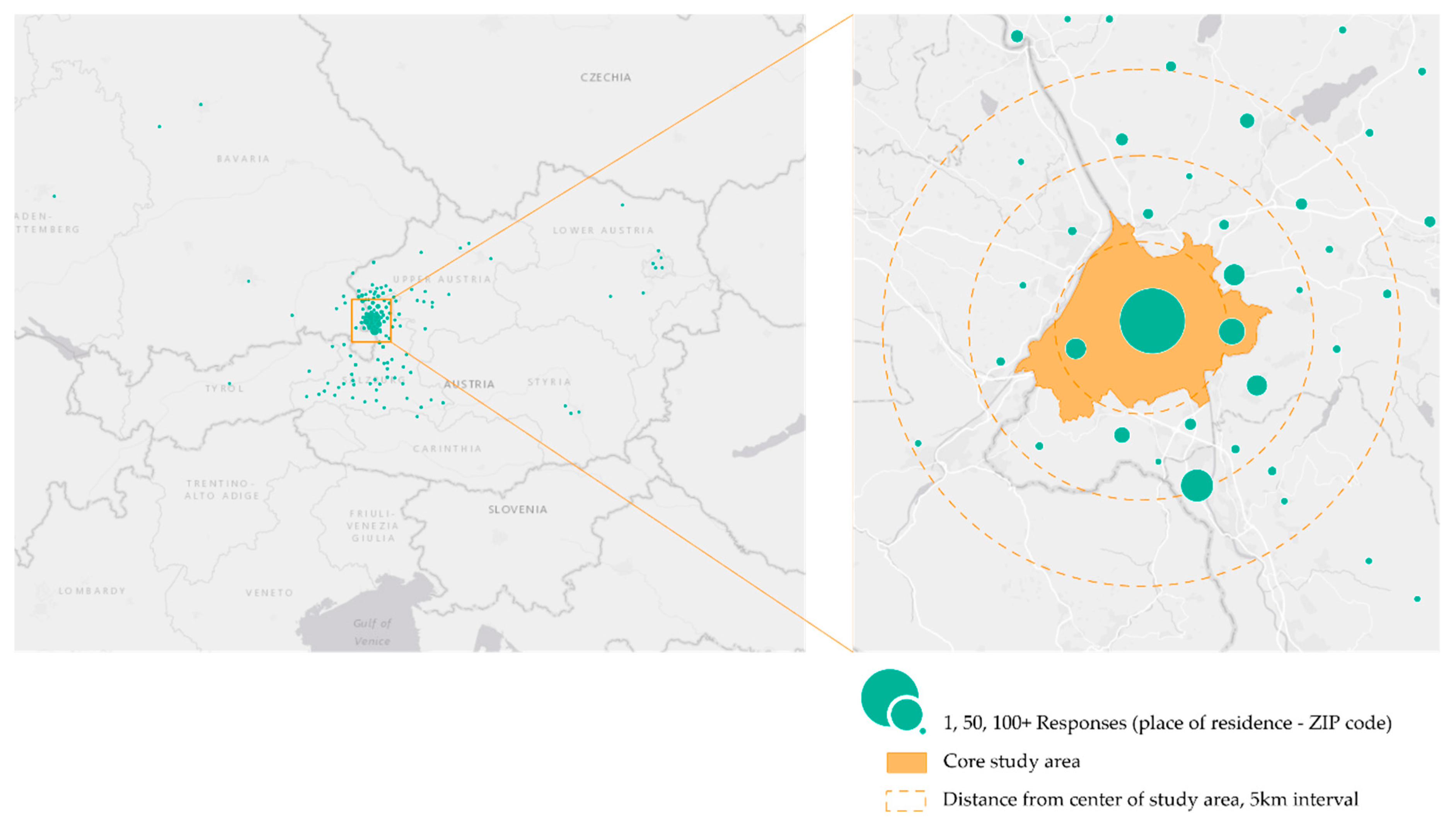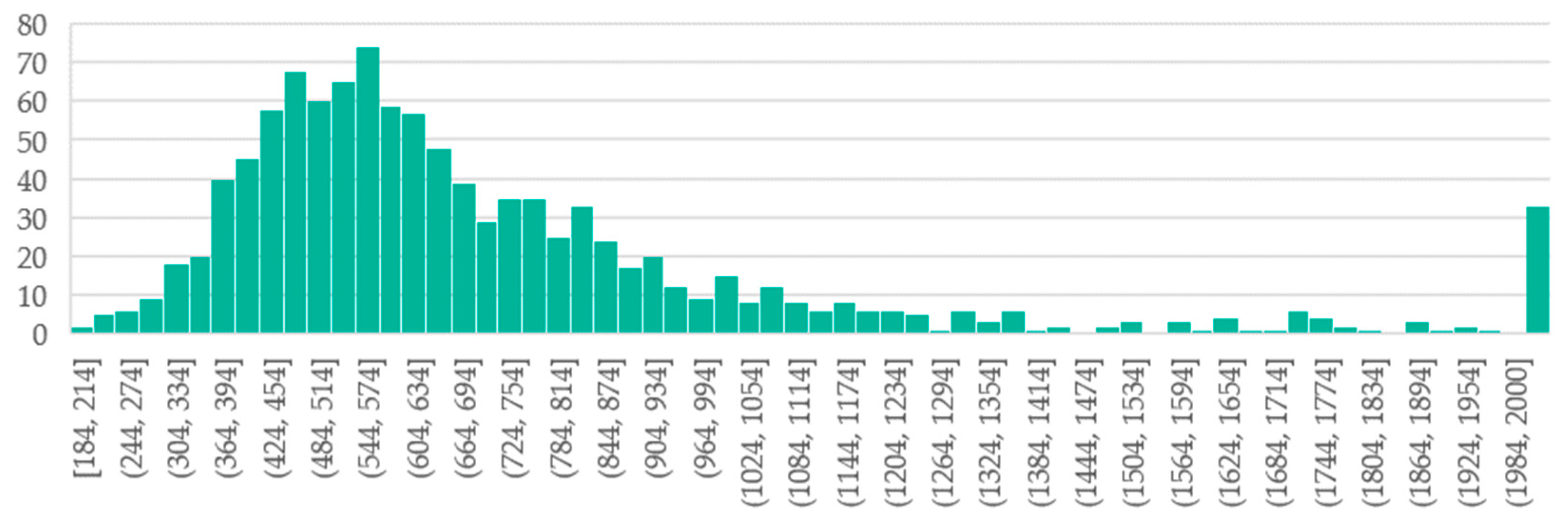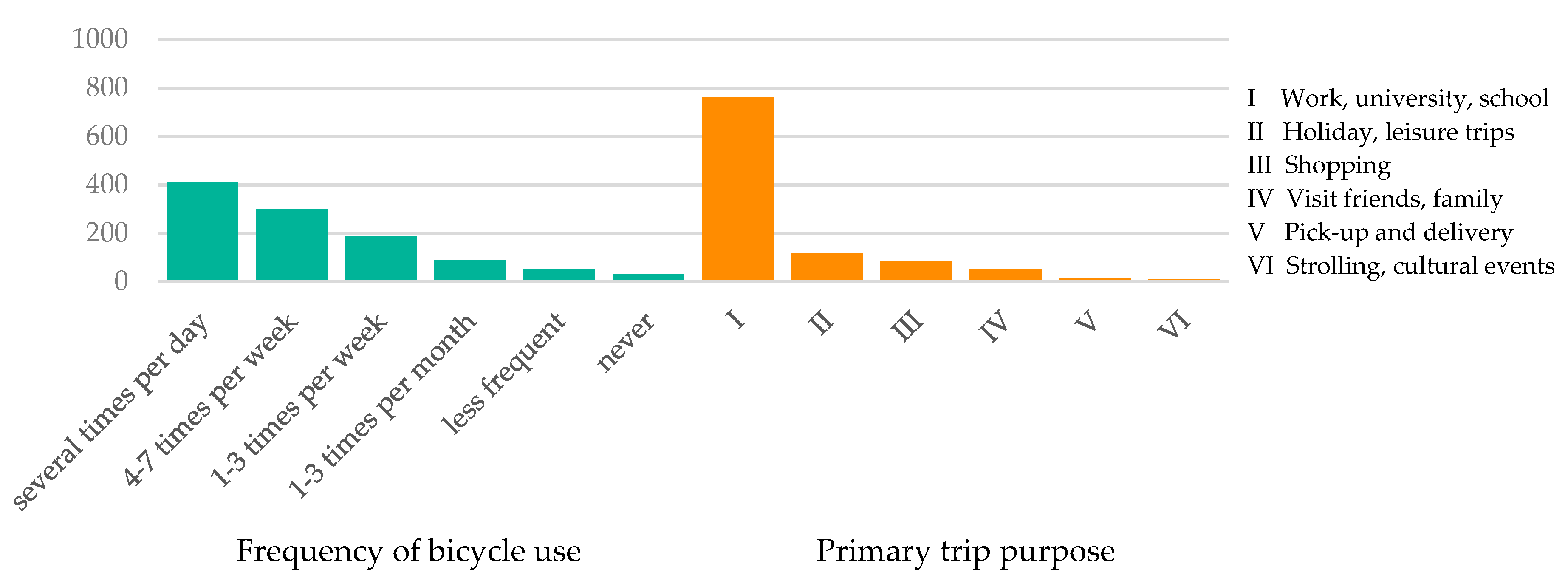Lifestyles and Cycling Behavior—Data from a Cross-Sectional Study
Abstract
1. Summary
1.1. Data Acquisition
1.2. Data Usage
2. Data Description
2.1. Fields and Values
2.2. Descriptive Data Statistics
3. Methods
Supplementary Materials
Author Contributions
Funding
Acknowledgments
Conflicts of Interest
Appendix A

|
|
|
|
|
|
|
|
|
|
|
|
|
|
|
|
|
|
|
|
|
|
|
|
|
|
|
|
|
|
|
|
|
|
|
|
|
|
|
|
|
|
|
|
|
|
|
|
|
|
|
|
|
|
|
|
|
|
|
|
|
|
|
|
|
|
|
|
|
|
|
|
|
|
|
|
|
|
|
|
|
|
|
|
|
|
|
|
|
|
|
|
|
|
|
|
|
|
References
- TEMS. City Modal Split Database. Available online: http://www.epomm.eu/tems/ (accessed on 10 October 2019).
- Pucher, J.; Buehler, R. Cycling towards a more sustainable transport future. Transp. Rev. 2017, 37, 689–694. [Google Scholar] [CrossRef]
- Dill, J.; McNeil, N. Four Types of Cyclists? Examination of Typology for Better Understanding of Bicycling Behavior and Potential. Transp. Res. Rec. 2013, 2387, 129–138. [Google Scholar] [CrossRef]
- Damant-Sirois, G.; Grimsrud, M.; El-Geneidy, A.M. What’s your type: A multidimensional cyclist typology. Transportation 2014, 41, 1153–1169. [Google Scholar] [CrossRef]
- Aldred, R.; Woodcock, J.; Goodman, A. Does More Cycling Mean More Diversity in Cycling? Transp. Rev. 2015, 36, 28–44. [Google Scholar] [CrossRef]
- Banister, D. The sustainable mobility paradigm. Transp. Policy 2008, 15, 73–80. [Google Scholar] [CrossRef]
- Selm, M.V.; Jankowski, N.W. Conducting Online Surveys. Qual. Quant. 2006, 40, 435–456. [Google Scholar] [CrossRef]
- Revilla, M. Analyzing Survey Characteristics, Participation, and Evaluation Across 186 Surveys in an Online Opt-In Panel in Spain. Methods Data Anal. 2017, 11, 135–162. [Google Scholar]
- LimeSurvey Project Team. LimeSurvey: An Open Source Survey Tool; LimeSurvey GmbH: Hamburg, Germany, 2003. [Google Scholar]
- Statistik Austria. STATatlas. Available online: https://www.statistik.at/atlas/ (accessed on 10 October 2019).
- Tomschy, R.; Steinacher, I. Österreich Unterwegs—Mit dem Fahrrad; Bundesministerium für Verkehr. Infrastruktur und Technologie: Vienna, Austria, 2017; p. 68. Available online: https://www.bmvit.gv.at/service/publikationen/verkehr/fuss_radverkehr/downloads/ou_fahrrad_web.pdf (accessed on 17 October 2019).






| Section | Topic | Question Format | Number of Questions |
|---|---|---|---|
| 1. Intro | Mobility behavior: mode choice, cycling frequency, bicycle availability | List (multiple and single choice) | 5 |
| 2. Personal information | Lifestyles and habits (general) | Bipolar scalar response (slider) | 15 |
| 3. Behavior | Cycling behavior: preferences, sensitivity to environmental factors, cycling style | Bipolar scalar response (slider) | 9 |
| 4. Motivators | Motivators and deterrents for cycling | Bipolar scalar response (slider), ranking | 9 |
| 5. Experience | Key moments in cycling | Free text | 1 |
| 6. Perspectives | Future role of cycling, potential promoters | Bipolar scalar response (slider), free text | 5 |
| 7. Socio-demographics | Media consumption, age, gender, education, ZIP code | Bipolar scalar response (slider), list (single choice), numeric response | 5 |
| Section | Question Number | Field Name | Values | Explanation & Comments |
|---|---|---|---|---|
| Metadata | ID | Unique ID for each session | ||
| time submitted | Time stamp for submission | Break-offs do not have a submission time stamp | ||
| last page | Numeric value [1 … 7] | Last visited page: the number indicates at which point respondents broke off the survey | ||
| time started | Time stamp | Time stamp of starting the survey | ||
| time last activity | Time stamp | Time stamp of last activity | ||
| 1. Intro | 1 | mode used today—car | Yes/No | Multiple choice question (“No” for unclicked) |
| 1 | mode used today—bicycle | Yes/No | Multiple choice question (“No” for unclicked) | |
| 1 | mode used today—bus | Yes/No | Multiple choice question (“No” for unclicked) | |
| 1 | mode used today—railway | Yes/No | Multiple choice question (“No” for unclicked) | |
| 1 | mode used today—walk | Yes/No | Multiple choice question (“No” for unclicked) | |
| 1 | mode used today—other | Free text | Participants could specify further modes (not translated) | |
| 2 | common mode—car | Yes/No | Multiple choice question (“No” for unclicked) | |
| 2 | common mode—bicycle | Yes/No | Multiple choice question (“No” for unclicked) | |
| 2 | common mode—bus | Yes/No | Multiple choice question (“No” for unclicked) | |
| 2 | common mode—railway | Yes/No | Multiple choice question (“No” for unclicked) | |
| 2 | common mode—walk | Yes/No | Multiple choice question (“No” for unclicked) | |
| 2 | common mode—other | Yes/No | Multiple choice question (“No” for unclicked) | |
| 3 * | cycling frequency | several times per day 4–7 times per week 1–3 times per week 1–3 times per month less frequent never | Single choice question (mandatory) | |
| 4 | everyone in household has an own bicycle | Yes/No | Single choice question (blank for unanswered) | |
| 5 | everyday bicycle type—eBike | Yes/No | Multiple choice question (“No” for unclicked) | |
| 5 | everyday bicycle type—eBike—detail | Free text | Participants were invited to provide more detailed information on their bicycle model | |
| 5 | everyday bicycle type—city or trekking | Yes/No | Multiple choice question (“No” for unclicked) | |
| 5 | everyday bicycle type—city or trekking—detail | Free text | Participants were invited to provide more detailed information on their bicycle model | |
| 5 | everyday bicycle type—mtb | Yes/No | Multiple choice question (“No” for unclicked) | |
| 5 | everyday bicycle type—mtb—detail | Free text | Participants were invited to provide more detailed information on their bicycle model | |
| 5 | everyday bicycle type—road bike | Yes/No | Multiple choice question (“No” for unclicked) | |
| 5 | everyday bicycle type—road bike—detail | Free text | Participants were invited to provide more detailed information on their bicycle model | |
| 5 | everyday bicycle type—special | Yes/No | Multiple choice question (“No” for unclicked) | |
| 5 | everyday bicycle type—special—detail | Free text | Participants were invited to provide more detailed information on their bicycle model | |
| 5 | everyday bicycle type—other | Yes/No | Multiple choice question (“No” for unclicked) | |
| 5 | everyday bicycle type—other—detail | Free text | Participants were invited to provide more detailed information on their bicycle model | |
| 2. Personal Information | 6 | comfortable—active | Numeric value [0…100] | Blank = unmoved slider, 50 = neutral |
| 7 | obey social norms—act independently | Numeric value [0…100] | Blank = unmoved slider, 50 = neutral | |
| 8 | independent—integrated | Numeric value [0…100] | Blank = unmoved slider, 50 = neutral | |
| 9 | outdoor activities—urban attractions | Numeric value [0…100] | Blank = unmoved slider, 50 = neutral | |
| 10 | destination—journey | Numeric value [0…100] | Blank = unmoved slider, 50 = neutral | |
| 11 | chaos and freedom—order and safety | Numeric value [0…100] | Blank = unmoved slider, 50 = neutral | |
| 12 | spontaneous—deliberative | Numeric value [0…100] | Blank = unmoved slider, 50 = neutral | |
| 13 | stability—change | Numeric value [0…100] | Blank = unmoved slider, 50 = neutral | |
| 14 | rather go for a run—rather read a book | Numeric value [0…100] | Blank = unmoved slider, 50 = neutral | |
| 15 | activities with friend or family—individual activities | Numeric value [0…100] | Blank = unmoved slider, 50 = neutral | |
| 16 | many loose friendships—few close friendships | Numeric value [0…100] | Blank = unmoved slider, 50 = neutral | |
| 17 | routine—improvisation | |||
| 18 | prefer it simple and clear—complex and detailed | Numeric value [0…100] | Blank = unmoved slider, 50 = neutral. This question was illustrated with two images. | |
| 19 | traditions—modern cities | Numeric value [0…100] | Blank = unmoved slider, 50 = neutral. This question was illustrated with two images. | |
| 20 | luxury—modesty | Numeric value [0…100] | Blank = unmoved slider, 50 = neutral. This question was illustrated with two images. | |
| 3. Behavior | 21 * | nice weather—any weather | Numeric value [0…100] | Blank = unmoved slider, 50 = neutral |
| 22 * | in any traffic situation—only protected bicycle ways | Numeric value [0…100] | Blank = unmoved slider, 50 = neutral | |
| 23 * | fastest, shortest route—more comfortable longer route | Numeric value [0…100] | Blank = unmoved slider, 50 = neutral | |
| 24 * | signposted routes—cross-country | Numeric value [0…100] | Blank = unmoved slider, 50 = neutral | |
| 25 | careful—self confident | Numeric value [0…100] | Blank = unmoved slider, 50 = neutral | |
| 26 | fast—gently | Numeric value [0…100] | Blank = unmoved slider, 50 = neutral | |
| 27 | wild—disciplined | Numeric value [0…100] | Blank = unmoved slider, 50 = neutral | |
| 28 | classic—punk | Numeric value [0…100] | Blank = unmoved slider, 50 = neutral | |
| 29 | need thrill—prefer calm and orderly | Numeric value [0…100] | Blank = unmoved slider, 50 = neutral | |
| 4. Motivators | 30 | means of transport—sports device | Numeric value [0…100] | Blank = unmoved slider, 50 = neutral |
| 31 * | use in everyday trips—special occasions | Numeric value [0…100] | Blank = unmoved slider, 50 = neutral | |
| 32 | pragmatic—lifestyle | Numeric value [0…100] | Blank = unmoved slider, 50 = neutral | |
| 33 | many do it—feel like it | Numeric value [0…100] | Blank = unmoved slider, 50 = neutral | |
| 34 | exhausting—sporty challenge | Numeric value [0…100] | Blank = unmoved slider, 50 = neutral | |
| 35 * | time savings | Numeric value [0…100] | Blank = unmoved slider, 0 = unimportant, 100 = very important | |
| 35 * | flexibility | Numeric value [0…100] | Blank = unmoved slider, 0 = unimportant, 100 = very important | |
| 35 * | comfort | Numeric value [0…100] | Blank = unmoved slider, 0 = unimportant, 100 = very important | |
| 35 * | low cost | Numeric value [0…100] | Blank = unmoved slider, 0 = unimportant, 100 = very important | |
| 35 * | health benefits | Numeric value [0…100] | Blank = unmoved slider, 0 = unimportant, 100 = very important | |
| 35 * | eco-friendliness | Numeric value [0…100] | Blank = unmoved slider, 0 = unimportant, 100 = very important | |
| 35 * | strengthening social contacts | Numeric value [0…100] | Blank = unmoved slider, 0 = unimportant, 100 = very important | |
| 35 * | image of cycling | Numeric value [0…100] | Blank = unmoved slider, 0 = unimportant, 100 = very important | |
| 35 * | pleasure of cycling | Numeric value [0…100] | Blank = unmoved slider, 0 = unimportant, 100 = very important | |
| 36 | cycling together—alone | Numeric value [0…100] | Blank = unmoved slider, 50 = neutral | |
| 37 | cycling is part of planning—planning independently | Numeric value [0…100] | Blank = unmoved slider, 50 = neutral | |
| 38 | common purpose 1 (most frequent) | Ranking of provided six different trip purposes | ||
| 38 | common purpose 2 | |||
| 38 | common purpose 3 | |||
| 38 | common purpose 4 | |||
| 38 | common purpose 5 | |||
| 38 | common purpose 6 | |||
| 5. Experience | 39 | key situation/turning point | Yes/No | |
| 39 | key situation/turning point: detail | Free text | Original free text in German language | |
| 39 | key situation/turning point: classification pos/neg | Pos/neg | Semantic classification of key situation in positive or negative experience (derived field) | |
| 39 | key situation/turning point: classification event | Tags | Tags for free text information (derived field) | |
| 6. Perspectives | 40 * | bicycle—walking | Numeric value [0…100] | Blank = unmoved slider, 50 = neutral |
| 40 * | car—public transport | Numeric value [0…100] | Blank = unmoved slider, 50 = neutral | |
| 40 * | public transport—bicycle | Numeric value [0…100] | Blank = unmoved slider, 50 = neutral | |
| 40 * | car—walking | Numeric value [0…100] | Blank = unmoved slider, 50 = neutral | |
| 41 | high priority—irrelevant | Numeric value [0…100] | Blank = unmoved slider, 50 = neutral | |
| 42 | personally increase cycling—not necessary | Numeric value [0…100] | Blank = unmoved slider, 50 = neutral | |
| 43 | required changes to increase my cycling frequency | Free text | Original free text in German language | |
| 44 | promotion activities are important—no interest in public role models | Numeric value [0…100] | Blank = unmoved slider, 50 = neutral | |
| 7. Socio-demographics | 45 | daily/weekly newspaper | Numeric value [0…100] | Blank = unmoved slider, 0 = infrequently, 100 = very frequently |
| 45 | news magazine | Numeric value [0…100] | Blank = unmoved slider, 0 = infrequently, 100 = very frequently | |
| 45 | television | Numeric value [0…100] | Blank = unmoved slider, 0 = infrequently, 100 = very frequently | |
| 45 | radio | Numeric value [0…100] | Blank = unmoved slider, 0 = infrequently, 100 = very frequently | |
| 45 | online media | Numeric value [0…100] | Blank = unmoved slider, 0 = infrequently, 100 = very frequently | |
| 45 | social media | Numeric value [0…100] | Blank = unmoved slider, 0 = infrequently, 100 = very frequently | |
| 46 * | gender | female/male/diverse | ||
| 47 * | year of birth | Numeric value | Year of birth | |
| 48 * | highest degree | Compulsory schoolApprenticeshipPost-secondary school diplomaUniversity level degreeOther | The options in German language correspond to Austrian education levels (Pflichtschule, Lehre, Matura, Höherer Ausbildungsabschluss) | |
| 49 * | ZIP code | Numeric value | ZIP code of place of residence | |
| Metadata | duration: total survey | Numeric values (seconds) | Duration of total survey in seconds | |
| duration: intro | Numeric values (seconds) | Duration of section 1 (page 1) in seconds | ||
| duration: general type | Numeric values (seconds) | Duration of section 2 (page 2) in seconds | ||
| duration: cycling style | Numeric values (seconds) | Duration of section 3 (page 3) in seconds | ||
| duration: reasons | Numeric values (seconds) | Duration of section 4 (page 4) in seconds | ||
| duration: key situation | Numeric values (seconds) | Duration of section 5 (page 5) in seconds | ||
| duration: wishes | Numeric values (seconds) | Duration of section 6 (page 6) in seconds | ||
| duration: person | Numeric values (seconds) | Duration of section 7 (page 7) in seconds |
© 2019 by the authors. Licensee MDPI, Basel, Switzerland. This article is an open access article distributed under the terms and conditions of the Creative Commons Attribution (CC BY) license (http://creativecommons.org/licenses/by/4.0/).
Share and Cite
Loidl, M.; Werner, C.; Heym, L.; Kofler, P.; Innerebner, G. Lifestyles and Cycling Behavior—Data from a Cross-Sectional Study. Data 2019, 4, 140. https://doi.org/10.3390/data4040140
Loidl M, Werner C, Heym L, Kofler P, Innerebner G. Lifestyles and Cycling Behavior—Data from a Cross-Sectional Study. Data. 2019; 4(4):140. https://doi.org/10.3390/data4040140
Chicago/Turabian StyleLoidl, Martin, Christian Werner, Laura Heym, Patrick Kofler, and Günther Innerebner. 2019. "Lifestyles and Cycling Behavior—Data from a Cross-Sectional Study" Data 4, no. 4: 140. https://doi.org/10.3390/data4040140
APA StyleLoidl, M., Werner, C., Heym, L., Kofler, P., & Innerebner, G. (2019). Lifestyles and Cycling Behavior—Data from a Cross-Sectional Study. Data, 4(4), 140. https://doi.org/10.3390/data4040140









